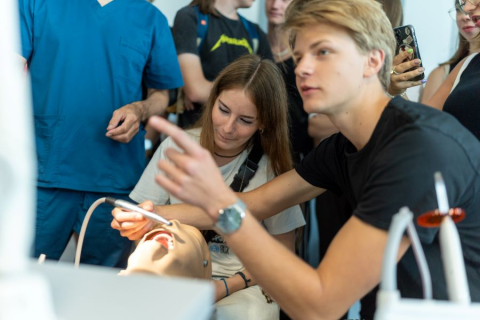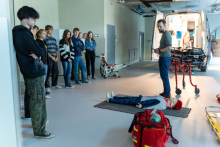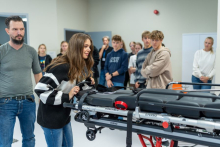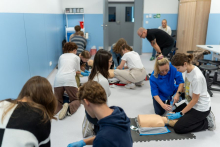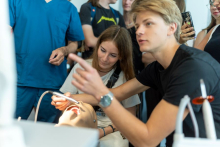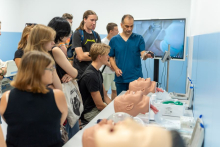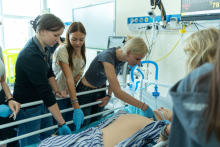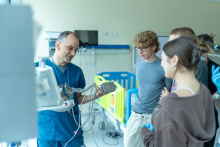Future medics, i.e. students from the faculties of medicine, dentistry, emergency medicine as well as nursing and midwifery, before facing real patients in the hospital, learn, on simulators and training equipment, practical skills such as inserting catheters, catheterizing the urinary bladder as well as how to properly deliver a baby or take care of a patient in the intensive care unit. To see what such classes look like, we have invited students from schools participating in the MUW Patronage Program and cooperating with our departments. Classes from 17 schools will visit us by the end of the month.
Real ambulance, amputee patient
In the largest room of the Medical Simulation Center stands a real, fully-equipped ambulance, which, although it can't leave, is a great place to practice situations resembling those that happen when an ambulance arrives to a patient's home or to an accident. Here, high school students (like university students) take on the role of paramedics and doctors. The instructor shows how to place the patient on a stretcher, how to put him in the ambulance. And how to carry him down the stairs if there is no elevator in the building. In a real academic class, you have to perform the task from A to Z - supply the patient, carry him into the ambulance and “drive away”. As the situation is played out, a voice from the control room can simulate the voices of, for example, a crying child or an adult in pain. After completing the task, the whole group watches the recording with an assistant to evaluate how they carried out the task: what went well and what needs to be improved.
- Here you can make mistakes, in real life you can't - stressed Natalia Psarska, a paramedic and instructor from MSC MUW, during a meeting with students from Stefan Żeromski High School in Warsaw.
In the room next door, students were able to practice CPR on mannequins and the proper use of automated external defibrillators (AEDs), which are increasingly being installed in public places (such as offices). Then they moved on to a simulated hospital emergency room. There's a real ventilator to which the patient has to be connected, there's an EKG and an apparatus showing saturation, pulse and pressure values on a screen. On the bed next to it lies a “patient” with an amputated leg, which all the high school students are eager to see and touch.
Silicone organ surgery
At our Medical Simulation Center, prospective students can also try an ultrasound and see what a ruptured liver looks like. And even try to do a laparoscopy. In the classes of scientific circles, the organs used for such “operations” are either silicone or 3D printed. A lot of excitement among young people visiting the MSC is usually aroused by the delivery room and our “patient” Victoria. She can “deliver” a baby with different skin tones - this helps teach students to rate the newborn's condition on the Apgar scale. If it is pale and blue it receives 0 points. The model can also imitate jaundice or cyanosis, for example.
- The birthing action for practicing is set for different times, and the simulators have natural voices uploaded: those of the laboring woman and the baby - the instructors explained to the high school students. - You can check how the baby is positioned in the abdomen. And finally: remember that the birth is delivered, not taken - they pointed out.
All visitors to the room are eager to pick up a simulated premature baby made of a mass that resembles the soft flesh and skin of a baby to the touch. In a crib lies a newborn who opens and closes his eyes and breathes, for example, as if he has dyspnea. On the table next to it lies a larger toddler who, for example, is crying because he feels pain when his liver is examined.
How to administer drugs vs. pulling a tooth
- All the “hospital” rooms have interactive whiteboards, where you need to make test orders, administer the drugs, that is, for example, write how much epinephrine to give and whether intramuscularly or orally - the instructors said. - The students “administer the drugs” by writing the appropriate doses on the board, and then on the screens you can perfectly see what it results in. Fortunately, this “patient” will not be harmed by an overdose - they consoled.
On the other hand, in the dental treatment room, high school students could feel like dentists, there are real drills and dental equipment.
- In the initial classes, it is safer for students to use simulators and treat plastic teeth that faithfully resemble real ones. Then, with the help of a scanner, the lecturer checks how the students have treated the tooth - explained Natalia Psarska.
After many highlights in the high-fidelity rooms, the high school students move on to the less real but also interesting rooms, where they watch how they teach to insert an intra-gastric tube, practice drawing blood and inserting intravenous line on artificial hands.
Will two hours spent in rooms faithfully recreating those of a hospital encourage high school students to enter medical school? We'll probably find out next year. We'll keep our fingers crossed during the recruitment process!
